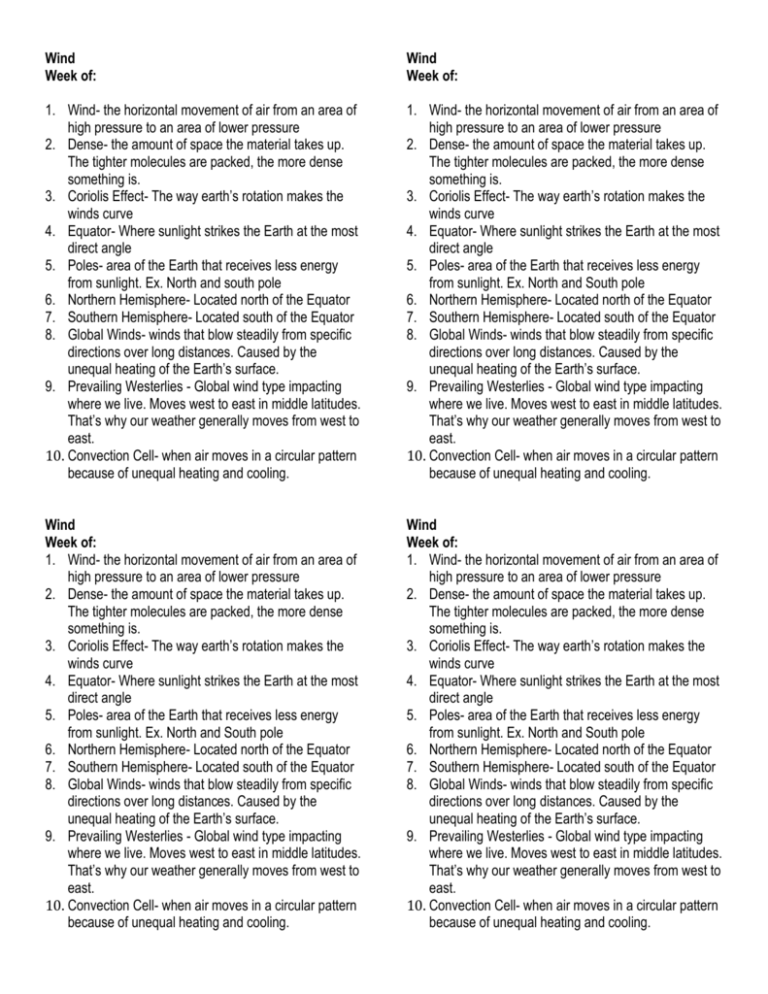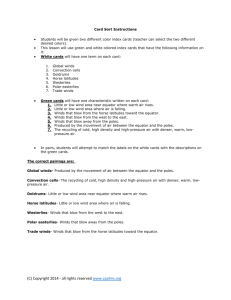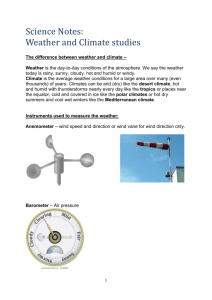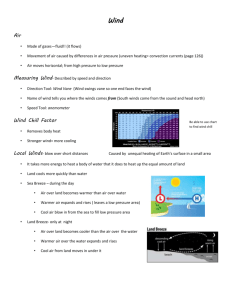Wind Vocabulary
advertisement

Wind Week of: Wind Week of: 1. Wind- the horizontal movement of air from an area of high pressure to an area of lower pressure 2. Dense- the amount of space the material takes up. The tighter molecules are packed, the more dense something is. 3. Coriolis Effect- The way earth’s rotation makes the winds curve 4. Equator- Where sunlight strikes the Earth at the most direct angle 5. Poles- area of the Earth that receives less energy from sunlight. Ex. North and south pole 6. Northern Hemisphere- Located north of the Equator 7. Southern Hemisphere- Located south of the Equator 8. Global Winds- winds that blow steadily from specific directions over long distances. Caused by the unequal heating of the Earth’s surface. 9. Prevailing Westerlies - Global wind type impacting where we live. Moves west to east in middle latitudes. That’s why our weather generally moves from west to east. 10. Convection Cell- when air moves in a circular pattern because of unequal heating and cooling. 1. Wind- the horizontal movement of air from an area of high pressure to an area of lower pressure 2. Dense- the amount of space the material takes up. The tighter molecules are packed, the more dense something is. 3. Coriolis Effect- The way earth’s rotation makes the winds curve 4. Equator- Where sunlight strikes the Earth at the most direct angle 5. Poles- area of the Earth that receives less energy from sunlight. Ex. North and South pole 6. Northern Hemisphere- Located north of the Equator 7. Southern Hemisphere- Located south of the Equator 8. Global Winds- winds that blow steadily from specific directions over long distances. Caused by the unequal heating of the Earth’s surface. 9. Prevailing Westerlies - Global wind type impacting where we live. Moves west to east in middle latitudes. That’s why our weather generally moves from west to east. 10. Convection Cell- when air moves in a circular pattern because of unequal heating and cooling. Wind Week of: 1. Wind- the horizontal movement of air from an area of high pressure to an area of lower pressure 2. Dense- the amount of space the material takes up. The tighter molecules are packed, the more dense something is. 3. Coriolis Effect- The way earth’s rotation makes the winds curve 4. Equator- Where sunlight strikes the Earth at the most direct angle 5. Poles- area of the Earth that receives less energy from sunlight. Ex. North and South pole 6. Northern Hemisphere- Located north of the Equator 7. Southern Hemisphere- Located south of the Equator 8. Global Winds- winds that blow steadily from specific directions over long distances. Caused by the unequal heating of the Earth’s surface. 9. Prevailing Westerlies - Global wind type impacting where we live. Moves west to east in middle latitudes. That’s why our weather generally moves from west to east. 10. Convection Cell- when air moves in a circular pattern because of unequal heating and cooling. Wind Week of: 1. Wind- the horizontal movement of air from an area of high pressure to an area of lower pressure 2. Dense- the amount of space the material takes up. The tighter molecules are packed, the more dense something is. 3. Coriolis Effect- The way earth’s rotation makes the winds curve 4. Equator- Where sunlight strikes the Earth at the most direct angle 5. Poles- area of the Earth that receives less energy from sunlight. Ex. North and South pole 6. Northern Hemisphere- Located north of the Equator 7. Southern Hemisphere- Located south of the Equator 8. Global Winds- winds that blow steadily from specific directions over long distances. Caused by the unequal heating of the Earth’s surface. 9. Prevailing Westerlies - Global wind type impacting where we live. Moves west to east in middle latitudes. That’s why our weather generally moves from west to east. 10. Convection Cell- when air moves in a circular pattern because of unequal heating and cooling.








